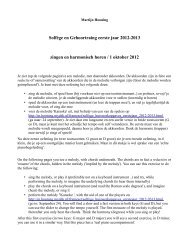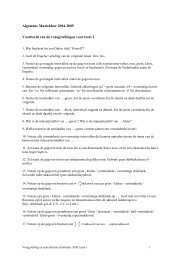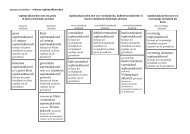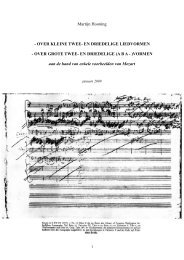Martijn Hooning SOME REMARKS ON SONATA FORM with an ...
Martijn Hooning SOME REMARKS ON SONATA FORM with an ...
Martijn Hooning SOME REMARKS ON SONATA FORM with an ...
Create successful ePaper yourself
Turn your PDF publications into a flip-book with our unique Google optimized e-Paper software.
Below is a brief discussion of the form.<br />
measures 1-12, slow introduction<br />
In Beethoven's time, the beginning of this movement must have sounded quite revolutionary: the<br />
first chord is not the tonic, but a domin<strong>an</strong>t seventh chord on C, so V7 to/in F. The home key of the<br />
piece is of course C major, but we could at first think that the home key is F major! In bar 2 though,<br />
we realize that the piece is in C major, <strong>an</strong>d we interprete the harmony in measures 1-4 as:<br />
(V7) → IV | V7 VI | (V7) → | V<br />
Remarkable is here the third /second combination 7 (returns at the beginning of the first theme, in<br />
measure 13, as a horizontal, motivic event).<br />
After these first four measures we are heading towards the domin<strong>an</strong>t of the home key - a usual<br />
practice in a slow introduction of a sonata form. In this sequel the "basic elements" play a big role,<br />
though they are sometimes somewhat hidde. See for example the movement from B to C in the<br />
upper voice (first violin) in measures 5 / 6, followed by the chromaticism C-C#-D , the motion<br />
7 → 5 → 1 in the bass in measures 7 <strong>an</strong>d 8, the chromatic line G - G# - A in the bass in measures<br />
9 / 10, <strong>an</strong>d the motion from ( E →) F → B ( → C ) in the upper voice in measure 12 (= part of a<br />
arpeggiated domin<strong>an</strong>t seventh chord).<br />
measures 13-106: Exposition<br />
measures 13-33: first theme<br />
This theme looks like a sentence at first sight, because we see:<br />
– a model of four measures (<strong>with</strong> the figure 5 → 7 → 1 followed by <strong>an</strong> arpeggiated triad),<br />
follwed by a sort of chromatic "connection" of two measures (17/18) 8 : I (V7) → II<br />
– a sequence, a tone higher, so: on the IInd degree, again followed by a sort of chromatic<br />
"connection": II II2md V6 / 5<br />
– shortening process from measure 26, so a group of (2 + 2) + 4 measures is created (note the<br />
arpeggiated domin<strong>an</strong>t seventh chord!)<br />
7 See the second example on page 8.<br />
8 Compare <strong>with</strong> the example on top of page 9: the chromatic line C-C#-D is clearly visible, <strong>an</strong>d the combination of a<br />
third <strong>an</strong>d a second has a role in connection <strong>with</strong> this line (A/C#/D)<br />
10






